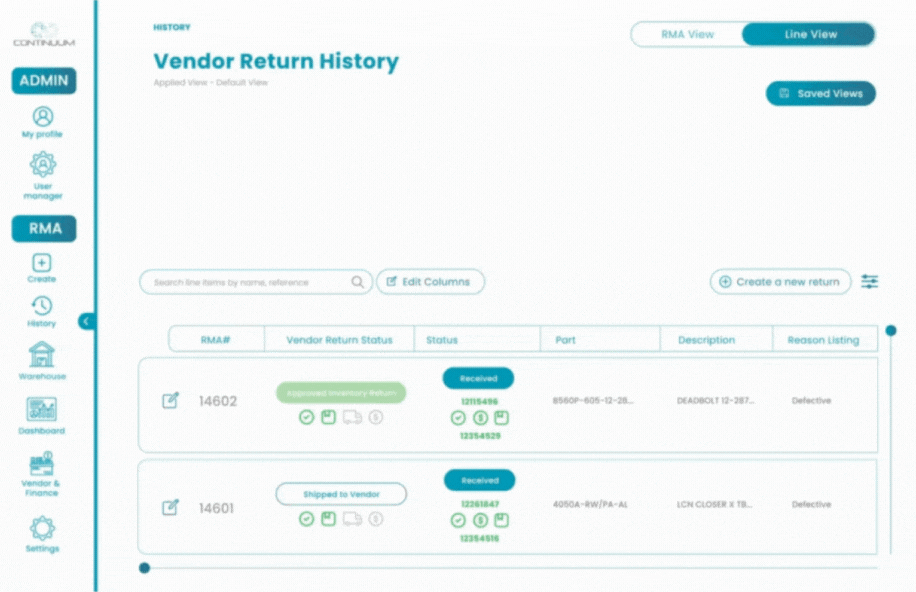The Pain Points of Return to Vendor and RGA Management

Managing Return to Vendor (RTV) and Return Goods Authorization (RGA) processes is a logistical and operational challenge for many distributors and manufacturers. These workflows are critical for recovering costs on defective, damaged, or unsellable goods — yet they’re often slowed by inefficiencies that drain time, money, and customer trust.
Common Challenges in RTV and RGA Workflows
1. Complex Vendor Defective Programs
- Vendors often allow multiple customer returns to be consolidated into a single vendor return, but without automation, tracking which customer RMAs map to which vendor RGA is chaotic.
- Each vendor has unique defective program requirements — from documentation and inspection protocols to strict timelines — often hidden in contracts or buried in vendor portals, making compliance difficult.
2. Slow RGA Approvals
- Manual submission and follow-up processes delay vendor approval, leaving defective inventory in warehouses for weeks.
- Vendors require detailed data — serial numbers, purchase history, defect codes — that’s hard to collect quickly without automation.
3. Credit Reconciliation Issues
- Matching vendor credits to customer credits issued is time-consuming and error-prone.
- Discrepancies between vendor-approved amounts and customer credits lead to financial leakage and unrecovered costs.
4. Disjointed Processes Across Teams
- RTVs and RGAs touch customer service, warehouse operations, and finance — but disconnected systems create bottlenecks and miscommunication.
How AI Transforms RTV and RGA Management
AI-powered automation solves these pain points by turning manual RTV and RGA management into a proactive, end-to-end, streamlined operation.
1. Simplifying Vendor Defective Programs with AI
AI can automatically interpret vendor defective program rules and ensure compliance:
- Mapping Customer Returns to Vendor Returns – Dynamically link customer RMAs to the correct vendor RGA for accurate tracking.
- Policy Interpretation – Read and extract vendor return policies from contracts, PDFs, and emails into actionable, searchable data.
- Automated Compliance Checks – Verify documentation, timelines, and inspection requirements before submission to prevent rejections.
Example: A distributor managing returns for a large electronics manufacturer can use AI to automatically match serialized items to the correct RGA program and attach required defect codes before submission.
2. AI Agents for RGA Approvals and Vendor Communication
AI agents remove the delays and manual follow-ups that slow RTV workflows:
- Automated RGA Creation & Submission – Populate vendor-specific forms with all required details and send via email, API, or vendor portal.
- Proactive Follow-Ups – Track open requests and escalate automatically to ensure timely vendor approvals.
- Vendor-Specific Workflow Adaptation – Adjust for whole-unit returns, part replacements, or specific defect categories without manual intervention.
Example: An HVAC distributor can enable contractors to submit claims via mobile app, with the AI agent generating the RGA, submitting to the vendor, and initiating a replacement order instantly.
3. Closing the Loop with AI Credit Reconciliation
Financial accuracy is essential for profitable RTV and RGA management. AI can:
- Match Vendor Credits to Customer Credits – Ensure a zero-sum balance between credits issued to customers and credits received from vendors.
- Flag Discrepancies – Identify short payments or missed credits for immediate resolution.
- Provide Real-Time Visibility – Show credit status across all transactions via automated dashboards.
Example: A distributor with $1M+ in defective goods at year-end can use AI to ensure every eligible credit is reclaimed, reducing write-offs and boosting profitability.
4. Streamlining Multi-Department RTV and RGA Workflows
AI connects siloed teams with a unified return-to-vendor process:
- Dynamic Vendor Forms – Auto-generate forms specific to each vendor’s requirements at return initiation.
- Real-Time Status Tracking – Give customer service, warehouse, and finance teams shared visibility from RMA initiation to vendor credit receipt.
The ROI of AI in RTV and RGA Processes
Businesses implementing AI-driven RTV and RGA automation see measurable results:
- Faster Turnaround – Shrink processing and approval times from weeks to days.
- Higher Cost Recovery – Reduce financial leakage through perfect credit reconciliation.
- Better Relationships – Increase transparency with vendors and improve customer trust.
- Lower Manual Workload – Free teams from paperwork, data entry, and follow-up tasks.
Conclusion: AI is the Future of RTV and RGA Management
With AI handling vendor policy interpretation, automated RGA submission, and real-time credit reconciliation, RTV and RGA processes become faster, more accurate, and fully auditable.
The result is a more efficient supply chain, stronger vendor relationships, and higher profitability — all while eliminating the bottlenecks that plague traditional RTV and RGA workflows.
If you’re ready to eliminate the pain points of RGA and RTV management, AI-powered automation can deliver the speed, accuracy, and control your operations need.
If you’d like, I can also create meta titles, meta descriptions, and H1/H2 structures so this article — along with your RMA-focused one — is fully optimized for search and campaign consistency. That will help them rank together for “RGA,” “RTV,” and “returns automation” queries.




Comments